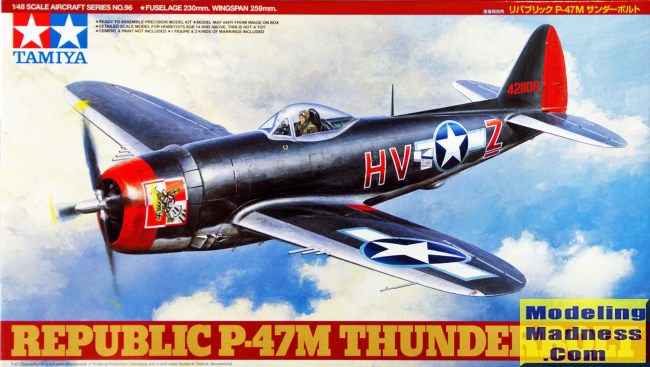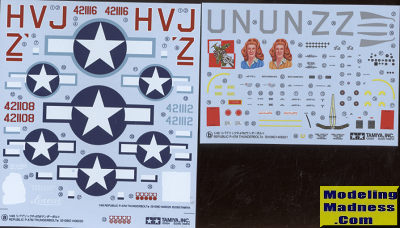
| KIT #: | 61096 |
| PRICE: | 2800 yen |
| DECALS: | Three options |
| REVIEWER: | Scott Van Aken |
| NOTES: | 2005 tooling |

| HISTORY |
The P-47M was a more conservative attempt to come up with a higher-performance ("Sprint") version of the Thunderbolt, designed to chase V-1 flying bombs, done, in part, by reducing armament from eight .50-caliber Colt-Browning M2 machine guns to six. In September 1944, four P-47D-27-RE airframes (42-27385/27388) were modified into prototype YP-47Ms by fitting the R-2800-57 engine and the GE CH-5 turbo-supercharger, a combination which could produce 2,800 hp (2,089 kW) at 32,500 ft (9,900 m) when using Wartime Emergency Power (water injection). Air brakes were added to the wing's lower surfaces to allow braking after a dive onto its prey. The YP-47M had a top speed of 473 mph (410 kn, 761 km/h) and it was put into limited production with 133 (sufficient for one group) built. However, the type suffered serious teething problems in the field due to the highly tuned engine. Engines were unable to reach operating temperatures and power settings and frequently failed in early flights from a variety of causes: ignition harnesses cracked at high altitudes, severing electrical connections between the magneto and distributor, and carburetor valve diaphragms also failed. Persistent oil tank ruptures in replacement engines were found to be the result of inadequate protection against saltwater corrosion during transshipment. In the end, it was simply errors made by the R-2800-57 model engine's manufacturers which led to these issues with the P-47M. By the time the bugs were worked out, the war in Europe was nearly over. However, P-47Ms still destroyed 15 enemy aircraft in aerial combat, normal results for any fighter type in March–May 1945 when aerial encounters with the Luftwaffe were rare. The entire production total of 130 P-47Ms were delivered to the 56th Fighter Group, and were responsible for all seven of that group's jet shoot-downs. Twelve were lost in operational crashes with the 56th Group resulting in 11 deaths, two after VE Day, and two (44-21134 on 13 April 1945 and 44-21230 on 16 April 1945) were shot down in combat (both by ground fire).
The second YP-47M (of the batch of four converted P-47Ds) was later fitted with new wings and served as the prototype for the P-47N.
| THE KIT |
One has to wonder why Tamiya would go through all the effort of producing a P-47M when it already had a P-47D bubbletop in their catalog. Tamiya is not a company that does a bunch of reboxings with just decal changes as do many others. I have two theories about that. One is that black planes sell very well and the 56th FG did have a black aircraft or two as you can see on the box art. Secondly, it was a neat way to get a late model P-47D into a kit.
You have probably read a lot about this kit already and seen several built up. Let us just say that you do get what pay for with a Tamiya kit. It has a more than adequate cockpit, nicely done engine, and the ability to provide some optional settings. For instance, you can build this with the canopy open or closed and the same goes for the intercooler exhaust doors on the fuselage sides. Flaps can be posed up or lowered. There are also optional things to hang from the underside. These include the large, flat fuel tank for the centerline as well as two types of tanks for the pylons on the wings. Bombs are also included for this if you wish to use them as are rocket launcher tubes.
Should you be wondering if this kit includes the dive brakes provided on the P-47M, those are included. Tamiya was obviously planning on this kit as they are an insert. Also an insert is the additional fin fillet that distinguishes the M and later D models, though it was retrofit.
 Instructions are well done and you have three options.
All these planes started unpainted metal and were painted in the field. In these
cases, only the upper side were painted and that does not include the leading
edge of the wings and stabs. Two have a single dark color on the upperside and
one has a variable camo scheme of two blue. All the upper colors have to be
mixed and you are provided a mixing ratio for those. Decals are nicely printed
and should be trouble-free.
Instructions are well done and you have three options.
All these planes started unpainted metal and were painted in the field. In these
cases, only the upper side were painted and that does not include the leading
edge of the wings and stabs. Two have a single dark color on the upperside and
one has a variable camo scheme of two blue. All the upper colors have to be
mixed and you are provided a mixing ratio for those. Decals are nicely printed
and should be trouble-free.
| CONCLUSIONS |
This was the third of Tamiya's P-47 line and with the inclusion of this into the fold, all of the major variants were now able to be modeled. What makes this kit so useful is that you can use it to do all of the late D versions and that includes those used post-war. Frankly that is the reason I bought this kit as I'd much rather do a Dominican Thunderbolt than something that operated during WWII.
| REFERENCES |
https://en.wikipedia.org/wiki/Republic_P-47_Thunderbolt#P-47M
February 2020
Copyright ModelingMadness.com. All rights reserved.
If you would like your product reviewed fairly and fairly quickly, please
contact the editor
or see other details in the
Note to
Contributors.
Back to the Main Page
Back to the Review
Index Page
Back to the Previews Index Page